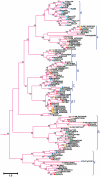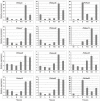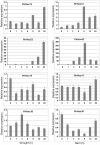Genome-wide identification, evolutionary expansion, and expression profile of homeodomain-leucine zipper gene family in poplar (Populus trichocarpa)
- PMID: 22359569
- PMCID: PMC3281058
- DOI: 10.1371/journal.pone.0031149
Genome-wide identification, evolutionary expansion, and expression profile of homeodomain-leucine zipper gene family in poplar (Populus trichocarpa)
Abstract
Background: Homeodomain-leucine zipper (HD-ZIP) proteins are plant-specific transcriptional factors known to play crucial roles in plant development. Although sequence phylogeny analysis of Populus HD-ZIPs was carried out in a previous study, no systematic analysis incorporating genome organization, gene structure, and expression compendium has been conducted in model tree species Populus thus far.
Principal findings: In this study, a comprehensive analysis of Populus HD-ZIP gene family was performed. Sixty-three full-length HD-ZIP genes were found in Populus genome. These Populus HD-ZIP genes were phylogenetically clustered into four distinct subfamilies (HD-ZIP I-IV) and predominately distributed across 17 linkage groups (LG). Fifty genes from 25 Populus paralogous pairs were located in the duplicated blocks of Populus genome and then preferentially retained during the sequential evolutionary courses. Genomic organization analyses indicated that purifying selection has played a pivotal role in the retention and maintenance of Populus HD-ZIP gene family. Microarray analysis has shown that 21 Populus paralogous pairs have been differentially expressed across different tissues and under various stresses, with five paralogous pairs showing nearly identical expression patterns, 13 paralogous pairs being partially redundant and three paralogous pairs diversifying significantly. Quantitative real-time RT-PCR (qRT-PCR) analysis performed on 16 selected Populus HD-ZIP genes in different tissues and under both drought and salinity stresses confirms their tissue-specific and stress-inducible expression patterns.
Conclusions: Genomic organizations indicated that segmental duplications contributed significantly to the expansion of Populus HD-ZIP gene family. Exon/intron organization and conserved motif composition of Populus HD-ZIPs are highly conservative in the same subfamily, suggesting the members in the same subfamilies may also have conservative functionalities. Microarray and qRT-PCR analyses showed that 89% (56 out of 63) of Populus HD-ZIPs were duplicate genes that might have been retained by substantial subfunctionalization. Taken together, these observations may lay the foundation for future functional analysis of Populus HD-ZIP genes to unravel their biological roles.
Conflict of interest statement
Figures












Similar articles
-
Genome-wide analysis of soybean HD-Zip gene family and expression profiling under salinity and drought treatments.PLoS One. 2014 Feb 3;9(2):e87156. doi: 10.1371/journal.pone.0087156. eCollection 2014. PLoS One. 2014. PMID: 24498296 Free PMC article.
-
Comprehensive characterization and RNA-Seq profiling of the HD-Zip transcription factor family in soybean (Glycine max) during dehydration and salt stress.BMC Genomics. 2014 Nov 3;15:950. doi: 10.1186/1471-2164-15-950. BMC Genomics. 2014. PMID: 25362847 Free PMC article.
-
Genome-wide identification, classification, and expression analysis of CDPK and its closely related gene families in poplar (Populus trichocarpa).Mol Biol Rep. 2013 Mar;40(3):2645-62. doi: 10.1007/s11033-012-2351-z. Epub 2012 Dec 15. Mol Biol Rep. 2013. PMID: 23242656
-
HD-ZIP Gene Family: Potential Roles in Improving Plant Growth and Regulating Stress-Responsive Mechanisms in Plants.Genes (Basel). 2021 Aug 17;12(8):1256. doi: 10.3390/genes12081256. Genes (Basel). 2021. PMID: 34440430 Free PMC article. Review.
-
Role of Homeodomain leucine zipper (HD-Zip) IV transcription factors in plant development and plant protection from deleterious environmental factors.Int J Mol Sci. 2013 Apr 12;14(4):8122-47. doi: 10.3390/ijms14048122. Int J Mol Sci. 2013. PMID: 23584027 Free PMC article. Review.
Cited by
-
Genome-Wide Identification and Expression Analysis of the HD-Zip Gene Family in Wheat (Triticum aestivum L.).Genes (Basel). 2018 Feb 1;9(2):70. doi: 10.3390/genes9020070. Genes (Basel). 2018. PMID: 29389910 Free PMC article.
-
Genome-Wide Investigation and Expression Profiling of HD-Zip Transcription Factors in Foxtail Millet (Setaria italica L.).Biomed Res Int. 2018 May 15;2018:8457614. doi: 10.1155/2018/8457614. eCollection 2018. Biomed Res Int. 2018. PMID: 29862293 Free PMC article.
-
Hsf and Hsp gene families in Populus: genome-wide identification, organization and correlated expression during development and in stress responses.BMC Genomics. 2015 Mar 14;16(1):181. doi: 10.1186/s12864-015-1398-3. BMC Genomics. 2015. PMID: 25887520 Free PMC article.
-
Expression Pattern of ERF Gene Family under Multiple Abiotic Stresses in Populus simonii × P. nigra.Front Plant Sci. 2017 Feb 20;8:181. doi: 10.3389/fpls.2017.00181. eCollection 2017. Front Plant Sci. 2017. PMID: 28265277 Free PMC article.
-
Genome-Wide Characterization and Expression Analysis of the HD-ZIP Gene Family in Response to Salt Stress in Pepper.Int J Genomics. 2021 Jan 25;2021:8105124. doi: 10.1155/2021/8105124. eCollection 2021. Int J Genomics. 2021. PMID: 33604369 Free PMC article.
References
-
- Gehring WJ, Qian YQ, Billeter M, Furukubo-Tokunaga K, Schier AF, et al. Homeodomain-DNA recognition. Cell. 1994;78:211–223. - PubMed
-
- Frank W, Phillips J, Salamini F, Bartels D. Two dehydration-inducible transcripts from the resurrection plant Craterostigma plantagineum encode interacting homeodomain-leucine zipper proteins. Plant J. 1998;15:413–421. - PubMed
Publication types
MeSH terms
LinkOut - more resources
Full Text Sources

